Residents of Southeast Asia consider rambutan one of the most wholesome fruits. But in our country, many do not even know how this fruit looks and what its taste is. The world learned more about this unusual fruit in the 18th century, when one of the Thai kings sang it in his treatise. The main idea of the work was that although outwardly the fruit is ugly, a delicate and tasty pulp is hidden behind its skin.
Material Content:
- 1 Rambutan - what kind of fruit is it and what does it look like?
- 2 How and where does rambutan grow?
- 3 What taste and smell does the fruit have?
- 4 Chemical composition and calorie content
- 5 Useful properties of rambutan and contraindications
- 6 Application in traditional medicine
- 7 Choose ripe rambutan
- 8 How to clean and eat fruit?
- 9 Rambutan and Litchi, what's the difference?
Rambutan - what kind of fruit is it and what does it look like?
For us, the appearance of this fruit is quite unusual. Bright fruit the size of an egg or a large walnut covered with red hairs resemble fluffy balls or chestnuts. Hair, depending on the variety, can have a greenish, red or pink color, and their length does not exceed 5 cm.
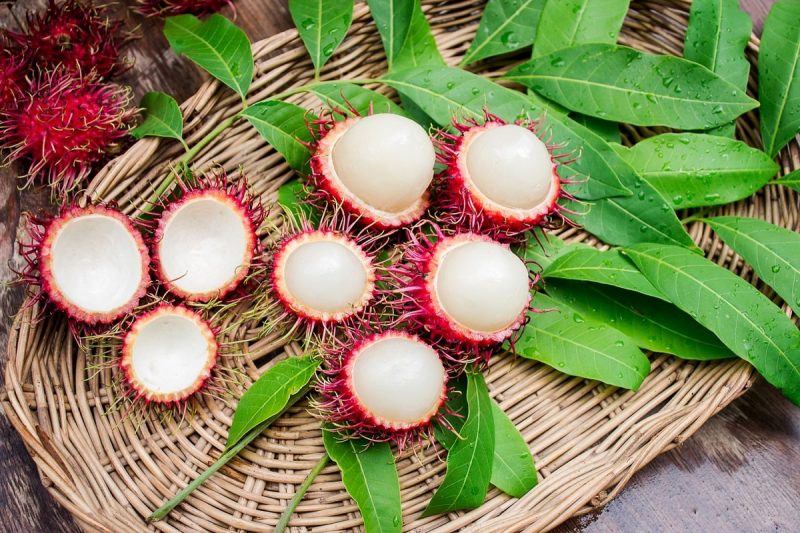
Inside is a jelly-like core and bone. Juicy pulp of beige, white, creamy or pink color has a dense texture.
How and where does rambutan grow?
The homeland of rambutan fruit is tropical countries - Thailand, Indonesia, Malaysia. In the wild, these evergreen tropical trees with a spreading crown grow to a height of 20 m, which is why collecting fruits is problematic. Moreover, wild species bear fruit only in late spring. Therefore, breeders have developed a new species, the maximum height of which does not exceed 5 m, and the fruiting period has increased significantly.
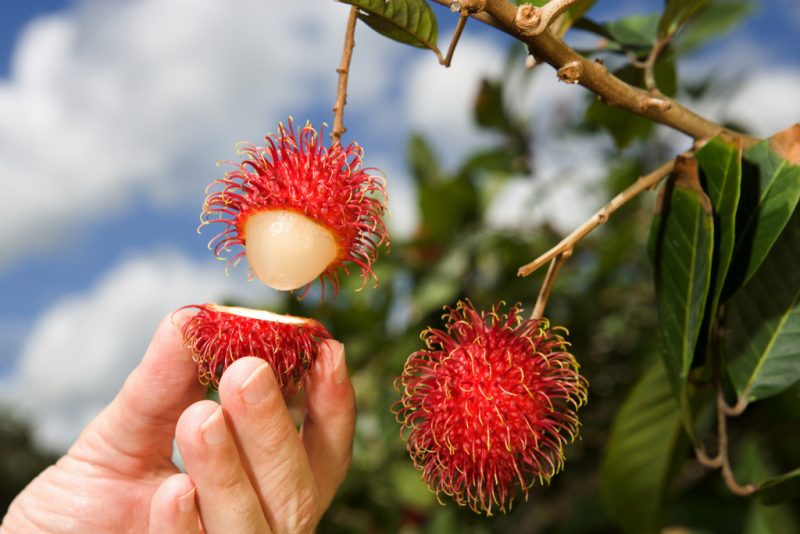
From one such tree, you can collect about 18-20 kg of crop. The season begins in May and lasts until mid-summer. Fruits grow in clusters of 20-30 pieces per branch.
What taste and smell does the fruit have?

Taste and smell depends on the variety. Most often, the pulp is sweet until cloying, but sometimes it has a slight sour flavor. The whole fruit is odorless, and the pulp itself is somewhat reminiscent of grapes. The fruit is very juicy, as it is 70% water. Therefore, it is often eaten in the heat to quench thirst.
Chemical composition and calorie content
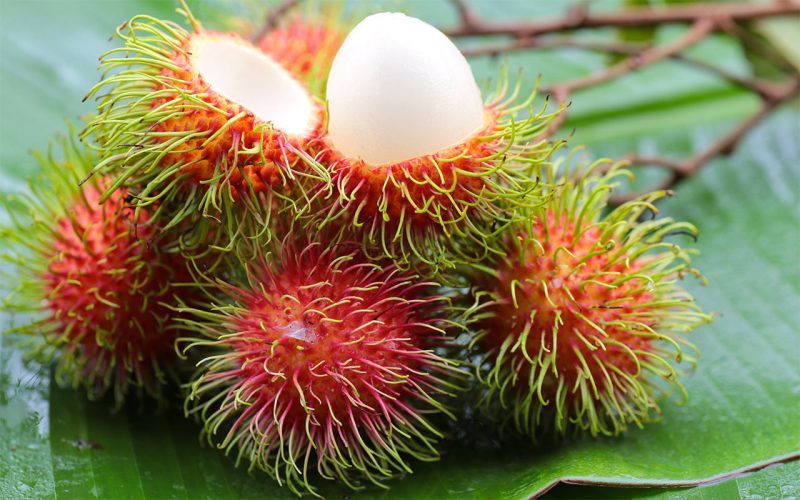
The composition of this exotic fruit has many useful substances:
- riboflavin;
- vitamins A, C, B6, B12;
- folic acid;
- thiamine;
- potassium;
- manganese;
- phosphorus;
- iron;
- protein.
It contains many dietary fibers that make the fruit beneficial for the digestive system. 100 g of fruits contain approximately 80 kcal.
Rambutan contains a lot of vitamin C, which has a beneficial effect on the immune system and protects the body from diseases. It is good to eat these fruits in case of anemia, since calcium and iron quickly raise hemoglobin levels. Potassium, copper, and magnesium reduce the risk of heart disease. Copper plays a large role in the absorption of iron and protein synthesis. Manganese is necessary for the normal functioning of the hormonal system.
Useful properties of rambutan and contraindications
Since the fruit is not very popular in our country, its beneficial properties are little known. But they are worth paying attention to.
In order for the skin to acquire a healthy and radiant appearance, it is enough to eat 3-4 fruits per day. It is also possible to make masks from the pulp, which are capable of much, since the fruit contains many active substances that contribute to the production of collagen.
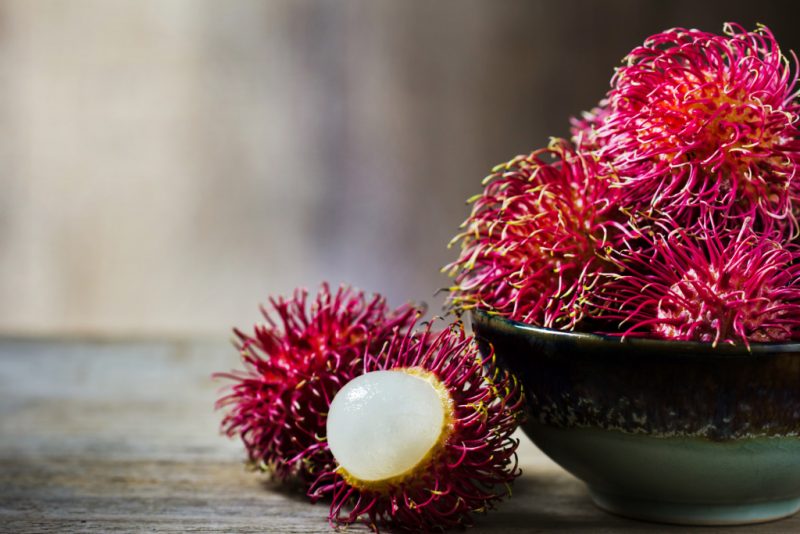
Eating these nutritious fruits regularly will help support poor health.
Therefore, this fruit must be included in the menu for people who have just suffered a severe and debilitating illness, as well as for athletes - after classes and training. Due to the presence of a large number of dietary fiber, the fruits have a beneficial effect on the digestive system.
Residents of Thailand believe that regular consumption of only 5 fruits per day reduces the likelihood of developing cancer by 90%. This fruit contains many antioxidants that destroy cancer cells.
Tourists know firsthand about digestive problems that occur after excessive consumption of exotic fruits. Therefore, you first need to try just a piece of an unfamiliar fruit to check the reaction to food. If everything is fine, you can try to eat more. But you should not eat more than 4-5 fruits per day.
There are no contraindications as such. The only caveat is a stomach ulcer. With this disease, it is better to refrain from eating fruit. People suffering from food allergies need to carefully familiarize themselves with its composition to make sure there are no allergens.
Application in traditional medicine
Indigenous peoples use not only fruits for their treatment, but also roots, bark and leaves.
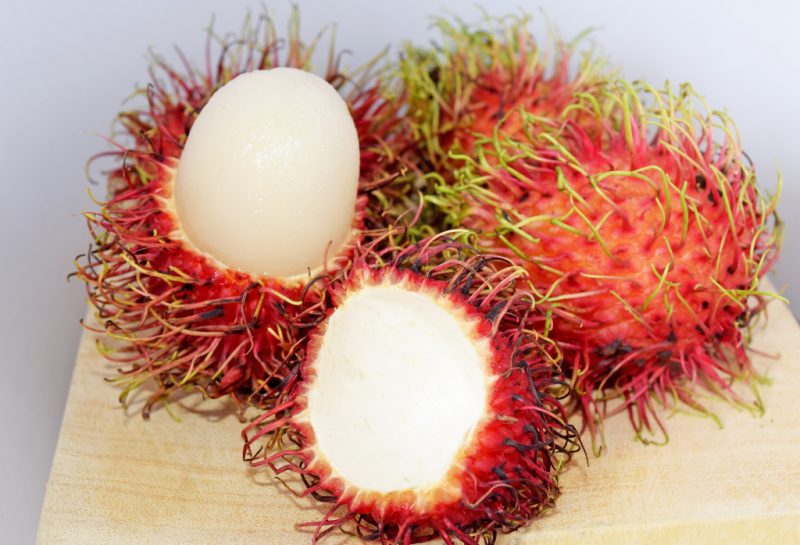
Fruit is used for different purposes:
- treatment of dysentery and diarrhea;
- destruction of intestinal worms;
- pressure reduction;
- making poultices for headaches.
The peel of the fetus is dried and stored until next year. Based on it, you can prepare medicines.
- A decoction of the roots helps with fever.
- Bark - with abscesses and inflammation in the oral mucosa.
- Leaves - with difficult to heal wounds, burns and abscesses.
Locals recommend drinking broth in the first days after childbirth, this helps to restore strength and establish lactation.
Choose ripe rambutan
It is better to pluck fruits directly from the branches, so they stay fresh longer and retain their properties. The freshness is indicated by sticking-out lettuce-colored hairs and a rich scarlet skin tone. They are kept in the refrigerator for a week.
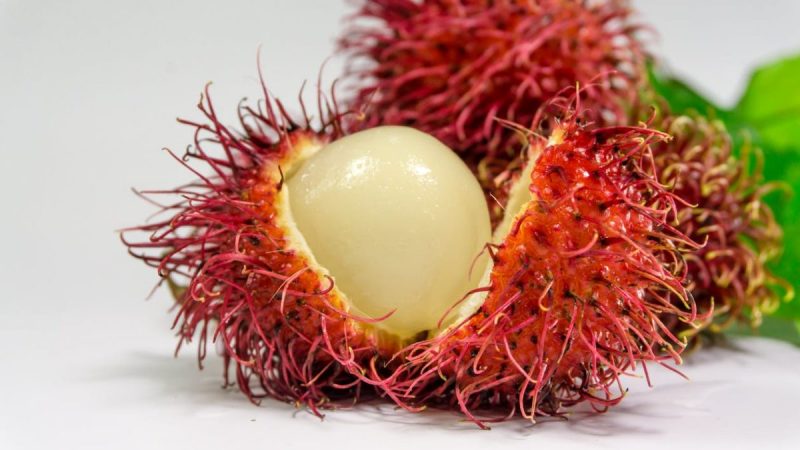
If the hairs are sluggish and yellow, and the peel is wrinkled and soft, then the fruit is stale.
The freshest fruits can be bought in those regions where industrial plantations are located.
How to clean and eat fruit?
Locals know best how to get to the pulp so as not to damage it.First you need to find a natural seam dividing the fetus into 2 parts, and carefully stretch it in different directions. If this succeeds, the pulp will remain intact and can be taken with your hands. If the pulp does not separate from the bone, then the fruit is overripe. This is not a big deal, but the pulp that is near the bone should not be eaten, as it may contain toxic substances.
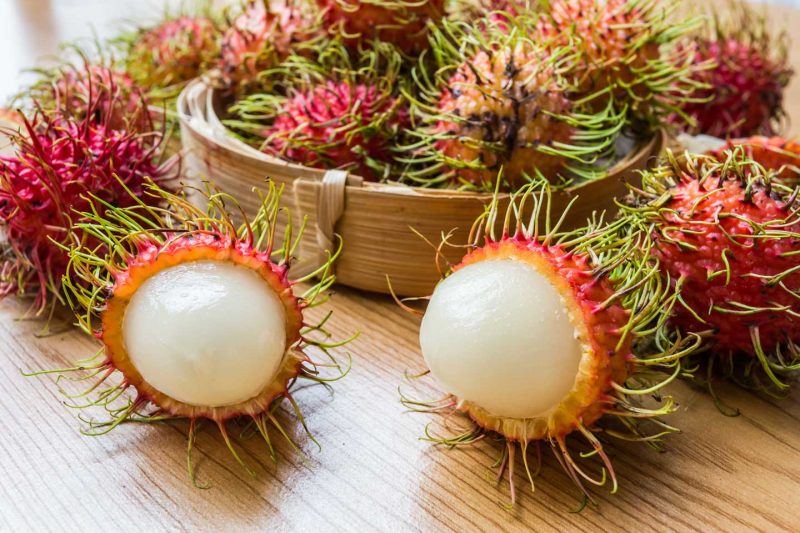
You can use a knife, but only the peel needs to be incised. If the fruit is cut in half, the pulp will flow out.
Raw bone is not eaten, it is bitter, but the fried seeds resemble acorns to taste. It is also used in the cosmetics industry for the manufacture of scented candles, essential oils and soaps.
Knowing how to clean and eat rambutan, you can often feast on this fruit. Many different desserts are prepared from the pulp - jam, sweet sauce, syrup, souffle, ice cream. It is also used for making cocktails, fruit salads or as a filling for baking. It is better to use fresh fruit, but in Indonesia and Thailand it is often canned with sugar.
Children can make tasty and healthy ice cream. The creamy mass is laid out in a bowl, several slices of pineapple, rambutan are spread on top and sprinkled with cinnamon.
Rambutan and Litchi, what's the difference?
The first difference is that rambutan can be found on sale from May to the end of September, and lychee only from mid-spring to June.

Outwardly, the fruits are also very different from each other. Lychee is much smaller than rambutan, the skin color is not red, but pink or purple, there are no hairs on it. Instead, the peel is covered with small bulges. The pulp is most often snow-white, resembles a sweet grape mass. Lychee does not tolerate transportation and is not subject to long preservation.
If you can try tropical fruits, you should definitely take advantage of this. Although they are unusual for most residents of the country, they have a delicate taste and useful properties.












